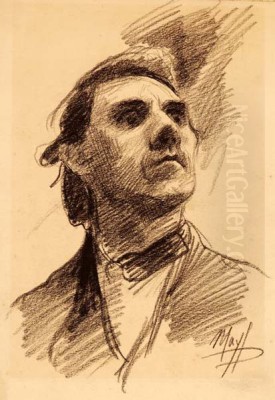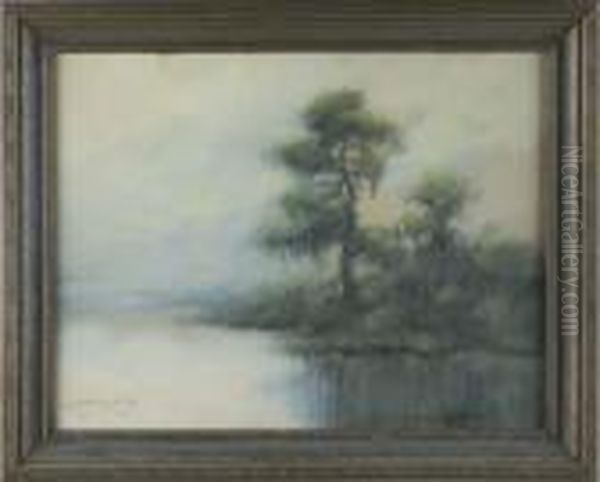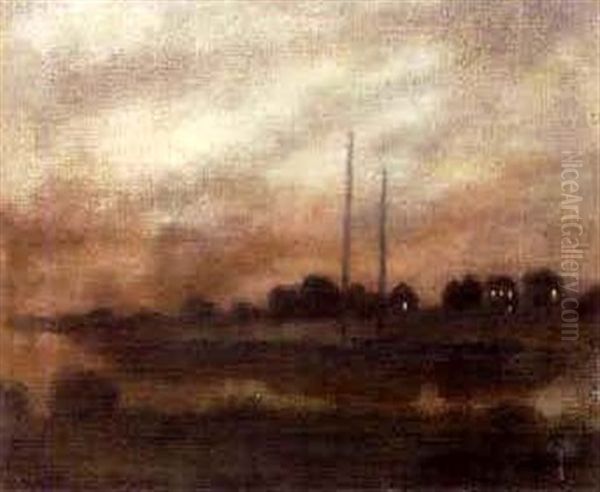
Alexander John Drysdale (1870-1934) stands as a significant figure in American Southern art, renowned primarily for his evocative and atmospheric depictions of the Louisiana landscape. Born in Marietta, Georgia, Drysdale became inextricably linked with New Orleans, where he spent the majority of his prolific career. His unique approach, particularly his development and mastery of the oil wash technique, allowed him to capture the humid, hazy, and often mystical quality of the region's bayous, swamps, and waterways, earning him a place as one of Louisiana's most beloved visual chroniclers. His journey from a potential career in banking to becoming a full-time, highly sought-after artist is a testament to his dedication and singular vision.
Early Life and Artistic Awakening
Alexander John Drysdale entered the world in 1870 in Marietta, Georgia, the son of a clergyman, Reverend Alexander John Drysdale Sr. His early life involved a relocation that would prove pivotal for his artistic path: the family moved to New Orleans, Louisiana, during his youth. This immersion in the unique culture and environment of the Crescent City undoubtedly shaped his later artistic sensibilities. Initially, however, art was not his primary pursuit. Like many young men of his time seeking stable employment, Drysdale began his working life in the banking industry.
Despite the practical demands of his banking job, the artistic impulse remained strong. Drysdale sought creative outlets and began attending night classes to study art. This period marked the beginning of his formal engagement with the visual arts and provided him with foundational skills. His decision to pursue art, even while maintaining his day job, indicates a growing passion that would eventually lead him to abandon finance for the less certain, but ultimately more fulfilling, life of a professional artist. The vibrant atmosphere of New Orleans, a city with a rich artistic heritage, provided fertile ground for his burgeoning talent.
Formal Training and Influences in New Orleans

Drysdale's commitment to art deepened as he sought more formal instruction. He enrolled at the Southern Art Union in New Orleans, an important institution fostering local talent. Here, he had the crucial opportunity to study under and interact with established New Orleans artists. Among his influential teachers were Paul E. Poincy (1833-1909), a respected figure known for his portraits and historical scenes, and Ida Haskell (1861-1932), another key member of the city's art community. Studying under these artists provided Drysdale with technical skills and exposed him to the prevailing artistic currents in the city.
Beyond his direct teachers, Drysdale's developing style absorbed influences from broader art historical movements. His early works show an affinity for the mood and atmospheric qualities of the French Barbizon School painters, such as Jean-Baptiste-Camille Corot, Théodore Rousseau, and Jean-François Millet, who emphasized realistic depictions of rural landscapes imbued with poetic feeling. He was also significantly influenced by American Tonalism, particularly the work of George Inness (1825-1894), whose landscapes prioritized subtle color harmonies, soft edges, and an overall sense of tranquility and spiritual resonance. Echoes of James McNeill Whistler's tonal experiments can also be discerned.
Furthermore, elements of Luminism, an American landscape painting style characterized by its meticulous rendering of light and atmosphere, particularly in tranquil, reflective water scenes, can be seen in Drysdale's focus on light effects. Artists like Fitz Henry Lane, Martin Johnson Heade, and Sanford Robinson Gifford pioneered this style, and its emphasis on serene, light-filled vistas resonated with Drysdale's interpretations of Louisiana's waterways. While not strictly an Impressionist, Drysdale also absorbed lessons from French Impressionism, particularly the work of Claude Monet and Camille Pissarro, regarding the capture of fleeting light effects and atmospheric conditions, though he translated these concerns into his own distinct technique.
The New Orleans Art Scene and Professional Development
By the turn of the century, Drysdale was actively integrating himself into the New Orleans art world. He became a member of the New Orleans Art Association, a vital organization that held exhibitions and provided a platform for local artists to showcase their work and interact. This affiliation was crucial for his professional development, offering visibility and camaraderie within the local artistic community. The city at this time boasted a vibrant scene, with artists like the brothers William Woodward (1859-1939) and Ellsworth Woodward (1861-1939), who were instrumental in founding the art program at Newcomb College, contributing significantly to the city's artistic life.

Other notable contemporaries in New Orleans whose paths Drysdale likely crossed included Andres Molinary (1847-1915), known for his portraits and Louisiana landscapes, Bror Anders Wikström (1854-1909), a Swedish-born painter and designer known for his Carnival float designs and marine paintings, and Achille Perelli (1822-1891), though slightly earlier, his legacy in detailed nature studies, particularly of fish and game, was part of the artistic milieu. Engaging with this community, exhibiting his work, and receiving feedback were essential steps in building his reputation.
In 1903, Drysdale made the decisive leap to become a full-time professional artist. He established his studio at 320 Exchange Place in the heart of the French Quarter, a location that placed him physically and symbolically at the center of the city's cultural life. This move signaled his complete commitment to his art and marked the beginning of his most productive period. His studio became a known spot, attracting patrons and visitors interested in his unique depictions of the surrounding landscapes.
The Signature Oil Wash Technique
A defining characteristic of Alexander John Drysdale's art is his innovative use of the oil wash technique. This method arose partly from economic necessity. Traditional oil paints and canvas were expensive materials, and Drysdale sought a more affordable way to produce his work, especially as demand grew. His solution was ingenious: he began diluting his oil paints significantly with kerosene. This thinning agent allowed the paint to behave more like watercolor, creating translucent layers and washes of color.
He often applied these thinned oils not to canvas, but to more economical supports like paperboard, academy board, or sometimes even textured paper. The technique involved layering these washes, allowing the texture of the board and the underlying tones to show through, contributing to the overall atmospheric effect. The kerosene dilution resulted in a relatively quick drying time compared to traditional oils, enabling him to work rapidly and prolifically.
The aesthetic result of the oil wash technique was perfectly suited to his chosen subject matter. It produced a soft, hazy, dreamlike quality, ideal for capturing the misty mornings, humid air, and shimmering reflections found in Louisiana's bayous and swamps. The technique allowed for subtle gradations of tone and color, creating depth and atmosphere without relying on heavy impasto or sharp detail. This signature style became instantly recognizable and highly popular, setting Drysdale apart from his contemporaries.
Subject Matter: The Louisiana Landscape Personified
Drysdale dedicated his artistic life almost exclusively to capturing the distinctive scenery of Louisiana. He was drawn to the unique beauty of the region's natural environment, finding endless inspiration in its swamps, bayous, rivers, and lakes. His paintings are populated with iconic elements of the Louisiana landscape: majestic live oak trees draped heavily with Spanish moss, cypress trees rising from still waters, winding bayous reflecting the sky, and expansive marshlands under changing light conditions.
He possessed a remarkable ability to convey the specific mood and atmosphere of these locations. His use of the oil wash technique was instrumental in this, allowing him to render the soft, diffused light filtering through the dense foliage, the misty haze rising from the water, and the tranquil, often melancholic, beauty of the swamps. His color palettes often favored muted greens, blues, grays, and ochres, reflecting the natural tones of the landscape while enhancing the overall atmospheric effect.
Drysdale's focus was not on topographical accuracy in the strictest sense, but rather on capturing the feeling and essence of the Louisiana landscape. His works evoke a sense of timelessness and mystery, inviting viewers to immerse themselves in the quiet solitude of these natural spaces. He frequently depicted scenes along the Mississippi River, Lake Pontchartrain, and the numerous bayous surrounding New Orleans, such as Bayou Teche and Bayou Lafourche. Through his consistent dedication to this subject matter, Drysdale effectively created a definitive visual identity for the Louisiana landscape in the collective imagination.
Major Works, Commissions, and Prolific Output
While Drysdale produced an astonishing number of works, certain paintings stand out as representative of his style and subject matter. Titles like Mossy Oak on the Bayou and Lagoon With Oaks encapsulate his typical themes, focusing on the interplay of water, trees, and atmosphere that defined his oeuvre. These works showcase his mastery of the oil wash technique, achieving the characteristic hazy, ethereal quality that made his art so popular.
Drysdale's reputation grew, leading to significant commissions. One notable project involved creating murals for the prestigious D.H. Holmes Department Store on Canal Street in New Orleans. These large-scale works, likely depicting Louisiana landscapes, adorned the store's dining room, bringing his art to a wider public audience in a prominent commercial setting. This commission underscored his status as a leading artist in the city.
Another important commission came later in his career when he was asked to create paintings for the newly constructed Shushan Airport (now New Orleans Lakefront Airport), a stunning Art Deco building opened in 1934. These works further cemented his association with major civic projects in New Orleans. His art was not confined to public commissions; it was widely sought after by private collectors throughout Louisiana and beyond, who appreciated his evocative portrayals of the local scenery. His prolific nature is legendary; estimates suggest he created around 10,000 works during his lifetime, a staggering number made possible by his rapid oil wash technique and consistent dedication.
Later Life, Recognition, and Legacy
Throughout the 1910s and 1920s, Alexander John Drysdale enjoyed considerable success and recognition. His paintings were widely collected, and his signature style was well-known throughout the region. He became, in essence, the painter laureate of the Louisiana landscape, his works defining the popular image of the state's natural beauty. His studio in the French Quarter was a fixture, and his consistent output ensured his visibility.
The Great Depression of the 1930s impacted artists across the nation. However, Drysdale received support during this challenging period through the Civil Works Administration (CWA), one of the New Deal programs designed to provide employment, including for artists. This federal support acknowledged his artistic importance and allowed him to continue working during the economic downturn, contributing works to public buildings and projects.
Alexander John Drysdale passed away in New Orleans in 1934, the same year the Shushan Airport, featuring his work, was dedicated. He left behind an immense body of work and an enduring legacy. He is remembered as a quintessential Louisiana artist whose unique technique perfectly captured the distinctive atmosphere of his adopted home state. His paintings continue to be highly valued by collectors and institutions, appreciated for their aesthetic beauty and their evocative portrayal of a specific regional identity. His influence extends beyond Louisiana, contributing to the broader narrative of American landscape painting in the early 20th century.
Conclusion: An Enduring Vision of Louisiana
Alexander John Drysdale carved a unique niche for himself in the annals of American art. Moving from Georgia to New Orleans, he absorbed the spirit of the Louisiana landscape and translated it into a distinctive visual language. Influenced by movements like the Barbizon School and Tonalism, and learning from local mentors like Paul E. Poincy, he forged his own path. His development of the oil wash technique, driven initially by practical concerns, became his artistic signature, allowing him to create thousands of works imbued with a characteristic hazy, dreamlike quality.
Through his relentless focus on the bayous, oaks, and waterways of Louisiana, Drysdale did more than just paint landscapes; he captured the soul of a region. His works, found in numerous collections and remembered through major commissions like those for D.H. Holmes and Shushan Airport, continue to resonate with viewers today. He remains a pivotal figure in Southern art, celebrated for his prolific output, his technical innovation, and his unwavering dedication to portraying the unique, atmospheric beauty of the Louisiana environment. His legacy is preserved in the countless canvases and boards that still evoke the misty mornings and moss-draped tranquility of the world he so masterfully depicted.